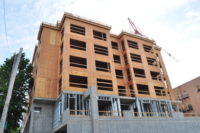Wolseley Projects Soft U.S. Housing Market, Modest Growth For 2007
Trading profit was down 15% due to Stock’s lower profitability. Reported revenue of the North American division was up 1.3%.
Trading profit declined after charging off costs relating to headcount reductions, branch closures and North American head office costs.
Ferguson produced another strong performance with a balance of organic growth and acquisitions, Wolseley reported. Investment continued to strengthen the company and to diversify its business. Commercial and industrial activity and continued focus on the repairs, maintenance and improvement (RMI) sector allowed for further outperformance in the first half, even as the new residential market declined.
Local currency revenue in the U.S. plumbing and heating operations rose by 18.8% to $5,384 million, with trading profit up by 13.4%.
Organic revenue growth of 9.1% was more than twice that of the market generally. Gross margin fell slightly due to tougher business conditions.
As expected, the trading margin of 6.2% was lower in the first half compared to the prior year’s first half margin of 6.5%, due to the initial impact of acquisitions, the effects of the weakening new residential markets and the absence of one-off commodity price gains of around $8 million that benefited the first half of 2006.
In response to the slowing new housing market in the first half, Ferguson reduced its headcount by about 1,000 from its peak in August 2006. A further 150 reductions have been made since Jan. 31. These reductions equate to about 5% of its total employees and should give rise to cost savings of about $12 million in the second half.
Based on expected market conditions for the second half, no further headcount reductions are planned in the United States. However, if markets show signs of weakening further, prompt action will be taken to reduce the cost base, Wolseley said.
Ferguson’s total branch numbers increased by 156 during the first half to 1,393 locations.
Wolseley projected a continued soft U.S. housing market for the remainder of the calendar year. The RMI and commercial and industrial markets are expected to continue to hold up. Ferguson should increase its market share and achieve good levels of organic growth, but at a more modest rate than the first half.
There will be no change to the Group’s overall financial targets of double-digit sales growth and a higher rate of profit growth while maintaining an incremental return on gross capital employed of at least 4% more than the pre-tax weighted average cost of capital, Wolseley reported. The Group still believes it has the potential to double its size over the next five to seven years in the fragmented markets in which it operates, equivalent to a compound annual growth rate of 10% to 14%.
Looking for a reprint of this article?
From high-res PDFs to custom plaques, order your copy today!




